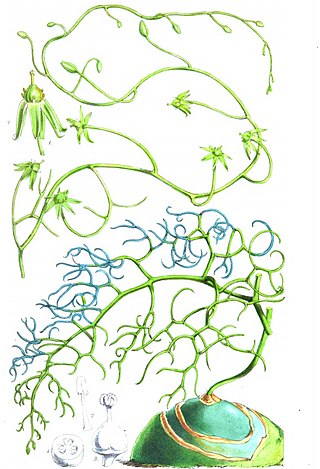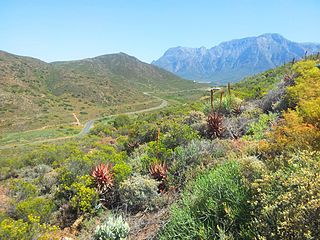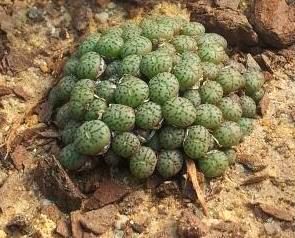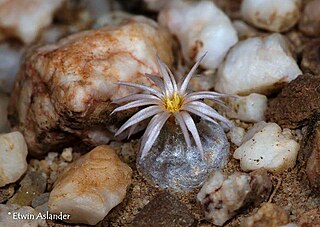
Pachypodium is a genus of succulent spine-bearing trees and shrubs, native to Madagascar and Africa. It belongs to the family Apocynaceae.
Pachypodiumhabitats consist of isolated, specialized, micro–environmental niches, generally xeric, rocky, frost-free areas within parts of western Madagascar and southern Africa. Pachypodium species are often indifferent to the regional ecological, biotic zone of vegetation, a fact which explains some of Pachypodium morphology and architecture. The large scale vegetation zones are in some cases irrelevant to the micro-environments of Pachypodium, in the sense that the xeric niches may be embedded in larger mesic biomes.

Gonialoe variegata, also known as tiger aloe and partridge-breasted aloe, is a species of flowering plant in the family Asphodelaceae. It is an evergreen succulent perennial indigenous to South Africa and Namibia. It is common in cultivation.

Conophytum is a genus of South African and Namibian succulent plants that belong to the family Aizoaceae. The name is derived from the Latin conus (cone) and Greek phytum (plant). The plants are also known as knopies, waterblasies, sphaeroids, conos, cone plants, dumplings, or button plants.

Albuca bracteata, is known by the common names pregnant onion, false sea onion, and sea-onion. It is a species of bulbous flowering plant in the family Asparagaceae. Its flowering stems can reach a height of 90 cm and can carry up to 100 greenish white flowers.

In botany, succulent plants, also known as succulents, are plants with parts that are thickened, fleshy, and engorged, usually to retain water in arid climates or soil conditions. The word succulent comes from the Latin word sucus, meaning "juice" or "sap".

Namaqua National Park is a South African national park situated approximately 495 km north of Cape Town and 22 km northwest of Kamieskroon. It has an area of more than 1300 km2. The park is part of Namaqualand, an area covering 55,000 km2 located within the semi-desert Succulent Karoo biome. This biome is a biodiversity hotspot with the largest concentration of succulent plants in the world. The park also has an arid environment with succulent plants. The park was created to protect its flowers. During the spring, wildflowers bloom there in a spectacular fashion. The park's main tourist attraction is this abundant spring bloom of brightly coloured wildflowers.

Aggeneys is a mining town established in 1976 on a farm of that name, situated between Pofadder and Springbok in the Northern Cape, South Africa.

Bowiea is a genus of bulbous, perennial, succulent plants which thrive in dry and desert regions of eastern and southern Africa. It is native to a region stretching from Kenya to Cape Province. The genus contains a single species, Bowiea volubilis.

Lapidaria is a monotypic genus of dwarf succulent plants in the family Aizoaceae. The only species it contains is Lapidaria margaretae, also known as the Karoo rose.

Muiria hortenseae ("mouse-head") is a rare dwarf species of succulent plant of the family Aizoaceae, indigenous to a very small area in the Little Karoo, Western Cape, South Africa. It is the only species in the monophyletic genus Muiria.

Robertson Karoo is a semi-arid vegetation type, restricted to sections of the Breede River Valley, Western Cape Province, South Africa. It is a subtype of Succulent Karoo and is characterised by the dominance of succulent plant species, and by several endemic plants and animals.

Conophytum calculus is a small South African species of succulent plant in the family Aizoaceae.

Conophytum breve is a small South African species of succulent plant of the genus Conophytum.

Conophytum flavum, the yellow cone plant, is a small South African species of succulent flowering plant of the family Aizoaceae.

Conophytum ficiforme is a small South African species of succulent plant of the genus Conophytum.

Conophytum truncatum is a small South African species of succulent plant of the genus Conophytum.

Conophytum piluliforme is a small South African species of succulent plant of the genus Conophytum.

Conophytum minimum is a small South African species of succulent plant of the genus Conophytum.

Conophytum hammeri is a small, endangered, South African species of succulent plant, of the genus Conophytum.





















